oil change FIAT FIORINO 2019 Owner handbook (in English)
[x] Cancel search | Manufacturer: FIAT, Model Year: 2019, Model line: FIORINO, Model: FIAT FIORINO 2019Pages: 220, PDF Size: 6.22 MB
Page 54 of 220

What it means What to do
redINSUFFICIENT ENGINE OIL PRESSURE/ENGINE OIL
DETERIORATED
When the key is turned to MAR the warning light
comes on, but should go out as soon as the engine is
started.
Steady light: Low engine oil pressure
The warning light comes on fixed, together with a
message on the display (for versions/markets, where
provided) when the system detects insufficient engine
oil pressure.
37)
On blinking: Engine oil deteriorated
(for Multijet versions only)
The warning light starts to flash together with a
message on the display (for versions/markets, where
provided) when the system detects that the engine oil
has deteriorated.
If the warning light flashes, this does not mean that the
vehicle is faulty, but simply informs the driver that it is
now necessary to change the engine oil as a result of
regular vehicle use. If the oil is not changed, warning
light
will also come on and engine operation is
limited to 3000 rpm when a second threshold is
reached.
If the oil is still not changed, when a third deterioration
threshold is reached, the engine is limited to 1500 rpm
to avoid damage.Contact a Fiat Dealership as soon as possible.
9)
Remember that the deterioration of the engine oil is
accelerated by:
– mainly town use of the vehicle which makes the DPF
regeneration process more frequent
– use of the vehicle for short trips, preventing the
engine from reaching operating temperature
– repeated interruption of the regeneration process,
signalled by the DPF warning light coming on.
52
KNOWING THE INSTRUMENT PANEL
Page 56 of 220

WARNING
34)If thewarning light turns on while driving (on certain versions together with the message on the display) stop the car immediately and
contact a Fiat Dealership.
35)The warning light
may not light up when the key is turned to MAR or stay on while travelling to indicate a retaining system fault. In this
case, the airbags or the pretensioners may not be activated in the case of an accident or (in a lesser number of cases) they may be activated
incorrectly. Before continuing, contact a Fiat Dealership to have the system checked immediately.
36)A failure of the
warning light is indicated by thewarning light flashing or, depending on the version, by theicon turning on
continuously on the display. In this case, thewarning light may not indicate a possible problem with the airbag restraint system. Before
continuing, contact a Fiat Dealership to have the system checked immediately.
37)If the
warning light switches on when travelling (on certain versions together with the message on the display), stop the engine
immediately and contact a Fiat Dealership.
WARNING
9)If the warning light switches on, the degraded engine oil must be changed as soon as possible, and never more than 500 km from the first
time that the warning light switches on. Failure to observe the above may result in severe damage to the engine and invalidate the warranty.
The activation of this warning light is not related to the amount of oil in the engine. Therefore, never top up with oil when the warning light
starts flashing.
54
KNOWING THE INSTRUMENT PANEL
Page 148 of 220
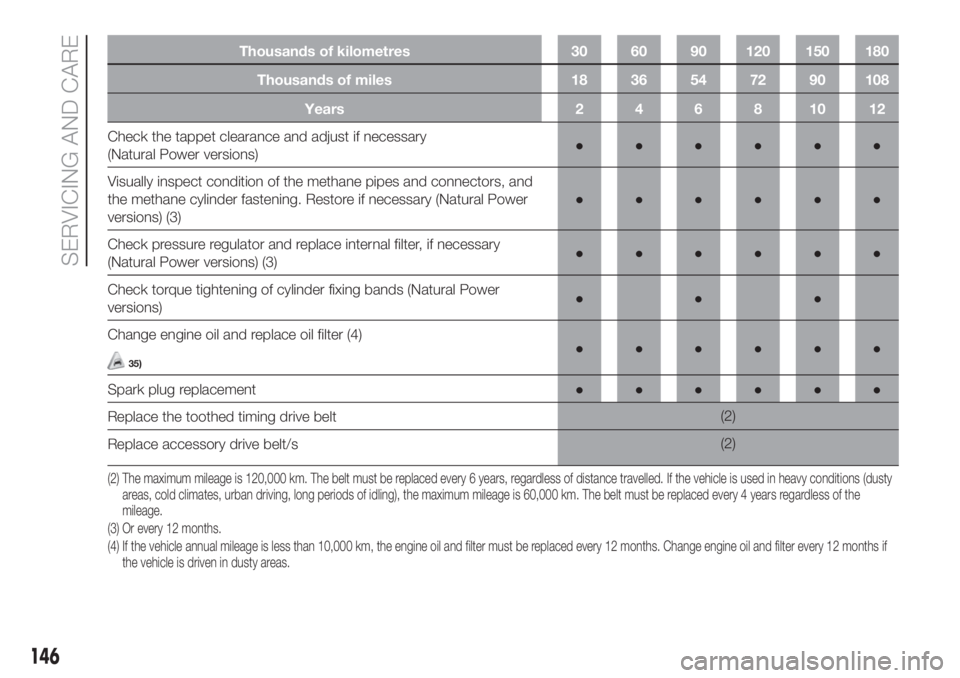
Thousands of kilometres 30 60 90 120 150 180
Thousands of miles 18 36 54 72 90 108
Years 2 4 6 8 10 12
Check the tappet clearance and adjust if necessary
(Natural Power versions)●●●●●●
Visually inspect condition of the methane pipes and connectors, and
the methane cylinder fastening. Restore if necessary (Natural Power
versions) (3)●●●●●●
Check pressure regulator and replace internal filter, if necessary
(Natural Power versions) (3)●●●●●●
Check torque tightening of cylinder fixing bands (Natural Power
versions)●●●
Change engine oil and replace oil filter (4)
35)●●●●●●
Spark plug replacement●●●●●●
Replace the toothed timing drive belt(2)
Replace accessory drive belt/s(2)
(3) Or every 12 months.
(4) If the vehicle annual mileage is less than 10,000 km, the engine oil and filter must be replaced every 12 months. Change engine oil and filter every 12months if
the vehicle is driven in dusty areas. (2) The maximum mileage is 120,000 km. The belt must be replaced every 6 years, regardless of distance travelled. If the vehicle is used in heavy conditions (dusty
areas, cold climates, urban driving, long periods of idling), the maximum mileage is 60,000 km. The belt must be replaced every 4 years regardless of the
mileage.
146
SERVICING AND CARE
Page 149 of 220
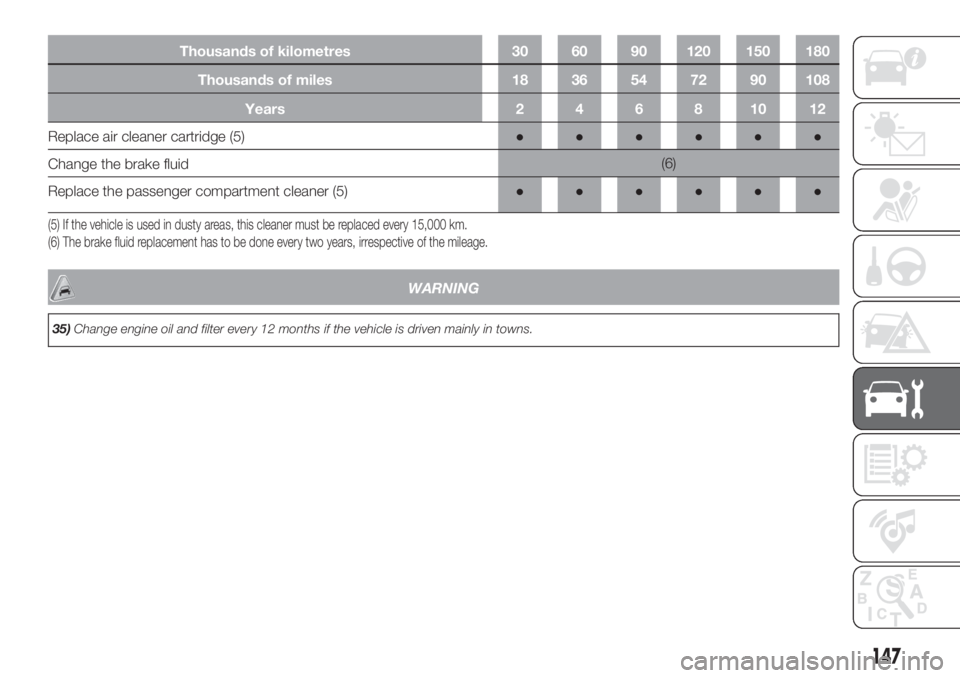
Thousands of kilometres 30 60 90 120 150 180
Thousands of miles 18 36 54 72 90 108
Years 2 4 6 8 10 12
Replace air cleaner cartridge (5)●●●●●●
Change the brake fluid(6)
Replace the passenger compartment cleaner (5)●●●●●●
(5) If the vehicle is used in dusty areas, this cleaner must be replaced every 15,000 km.
(6) The brake fluid replacement has to be done every two years, irrespective of the mileage.
WARNING
35)Change engine oil and filter every 12 months if the vehicle is driven mainly in towns.
147
Page 152 of 220

Thousands of kilometres 35 70 105 140 175
Thousands of miles 21 42 63 84 105
Years 2 4 6 8 10
Change engine oil and replace oil filter (versions with DPF)(4)
Replace accessory drive belt/s(3)
Replace fuel filter cartridge (5)●●
Replace air cleaner cartridge●●●●●
Change the brake fluid(6)
Replace the passenger compartment cleaner●●●●●
(4) The effective interval for changing the oil and replacing the engine oil filter depends on the car usage conditions and is signalled by the warning light or message
(if present) on the instrument panel (see “Warning lights and messages” paragraph in the "Knowing the instrument panel" chapter). In any case, it mustnever
exceed 24 months. Change engine oil and filter every 12 months if the vehicle is driven mainly in towns. (3) The maximum mileage is 120,000 km. The belt must be replaced every 6 years, regardless of distance travelled. If the vehicle is used in heavy conditions (dusty
areas, cold climates, urban driving, long periods of idling), the maximum mileage is 60,000 km. The belt must be replaced every 4 years regardless of the
mileage.
(5) When refuelling the vehicle with a quality below the relevant European specification, this filter must be replaced every 35,000 km.
(6) The brake fluid replacement has to be done every two years, irrespective of the mileage.
150
SERVICING AND CARE
Page 153 of 220
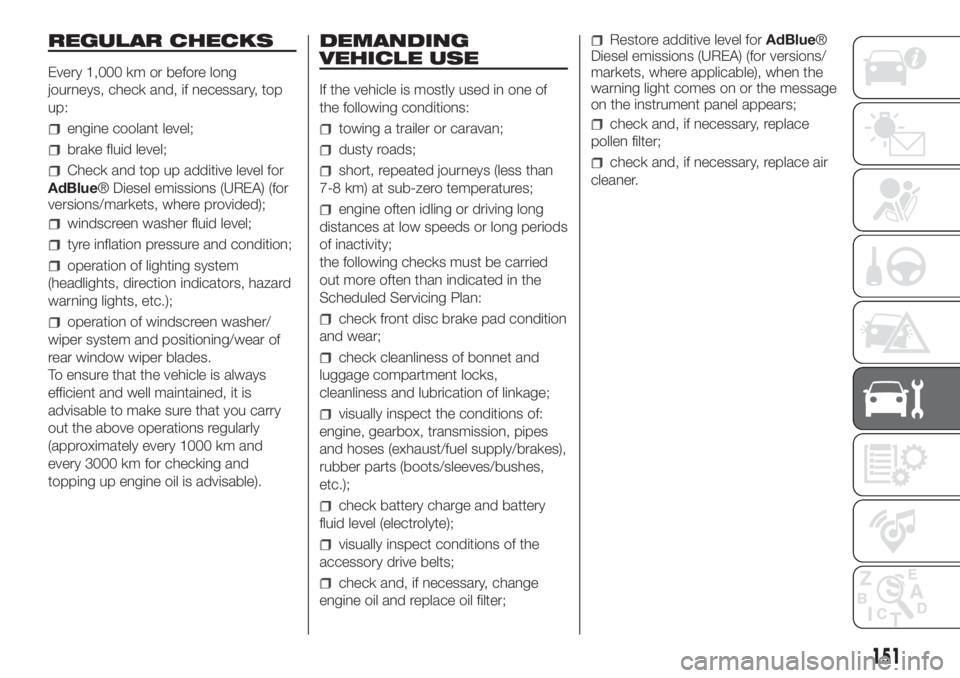
REGULAR CHECKS
Every 1,000 km or before long
journeys, check and, if necessary, top
up:
engine coolant level;
brake fluid level;
Check and top up additive level for
AdBlue® Diesel emissions (UREA) (for
versions/markets, where provided);
windscreen washer fluid level;
tyre inflation pressure and condition;
operation of lighting system
(headlights, direction indicators, hazard
warning lights, etc.);
operation of windscreen washer/
wiper system and positioning/wear of
rear window wiper blades.
To ensure that the vehicle is always
efficient and well maintained, it is
advisable to make sure that you carry
out the above operations regularly
(approximately every 1000 km and
every 3000 km for checking and
topping up engine oil is advisable).
DEMANDING
VEHICLE USE
If the vehicle is mostly used in one of
the following conditions:
towing a trailer or caravan;
dusty roads;
short, repeated journeys (less than
7-8 km) at sub-zero temperatures;
engine often idling or driving long
distances at low speeds or long periods
of inactivity;
the following checks must be carried
out more often than indicated in the
Scheduled Servicing Plan:
check front disc brake pad condition
and wear;
check cleanliness of bonnet and
luggage compartment locks,
cleanliness and lubrication of linkage;
visually inspect the conditions of:
engine, gearbox, transmission, pipes
and hoses (exhaust/fuel supply/brakes),
rubber parts (boots/sleeves/bushes,
etc.);
check battery charge and battery
fluid level (electrolyte);
visually inspect conditions of the
accessory drive belts;
check and, if necessary, change
engine oil and replace oil filter;
Restore additive level forAdBlue®
Diesel emissions (UREA) (for versions/
markets, where applicable), when the
warning light comes on or the message
on the instrument panel appears;
check and, if necessary, replace
pollen filter;
check and, if necessary, replace air
cleaner.
151
Page 159 of 220
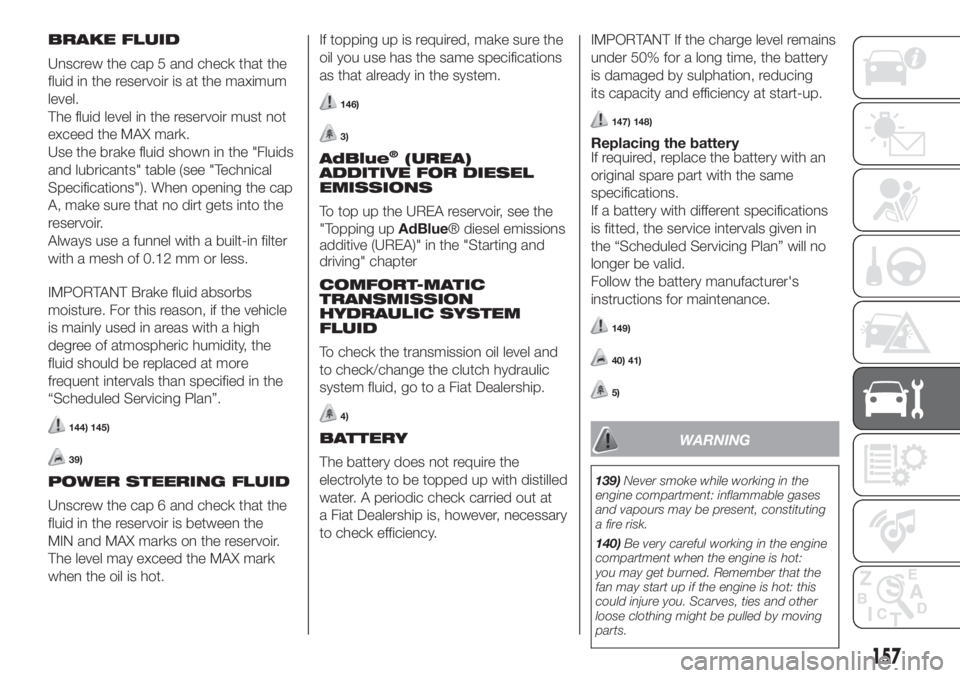
BRAKE FLUID
Unscrew the cap 5 and check that the
fluid in the reservoir is at the maximum
level.
The fluid level in the reservoir must not
exceed the MAX mark.
Use the brake fluid shown in the "Fluids
and lubricants" table (see "Technical
Specifications"). When opening the cap
A, make sure that no dirt gets into the
reservoir.
Always use a funnel with a built-in filter
with a mesh of 0.12 mm or less.
IMPORTANT Brake fluid absorbs
moisture. For this reason, if the vehicle
is mainly used in areas with a high
degree of atmospheric humidity, the
fluid should be replaced at more
frequent intervals than specified in the
“Scheduled Servicing Plan”.
144) 145)
39)
POWER STEERING FLUID
Unscrew the cap 6 and check that the
fluid in the reservoir is between the
MIN and MAX marks on the reservoir.
The level may exceed the MAX mark
when the oil is hot.If topping up is required, make sure the
oil you use has the same specifications
as that already in the system.
146)
3)
AdBlue®(UREA)
ADDITIVE FOR DIESEL
EMISSIONS
To top up the UREA reservoir, see the
"Topping upAdBlue® diesel emissions
additive (UREA)" in the "Starting and
driving" chapter
COMFORT-MATIC
TRANSMISSION
HYDRAULIC SYSTEM
FLUID
To check the transmission oil level and
to check/change the clutch hydraulic
system fluid, go to a Fiat Dealership.
4)
BATTERY
The battery does not require the
electrolyte to be topped up with distilled
water. A periodic check carried out at
a Fiat Dealership is, however, necessary
to check efficiency.IMPORTANT If the charge level remains
under 50% for a long time, the battery
is damaged by sulphation, reducing
its capacity and efficiency at start-up.
147) 148)
Replacing the battery
If required, replace the battery with an
original spare part with the same
specifications.
If a battery with different specifications
is fitted, the service intervals given in
the “Scheduled Servicing Plan” will no
longer be valid.
Follow the battery manufacturer's
instructions for maintenance.
149)
40) 41)
5)
WARNING
139)Never smoke while working in the
engine compartment: inflammable gases
and vapours may be present, constituting
a fire risk.
140)Be very careful working in the engine
compartment when the engine is hot:
you may get burned. Remember that the
fan may start up if the engine is hot: this
could injure you. Scarves, ties and other
loose clothing might be pulled by moving
parts.
157
Page 160 of 220
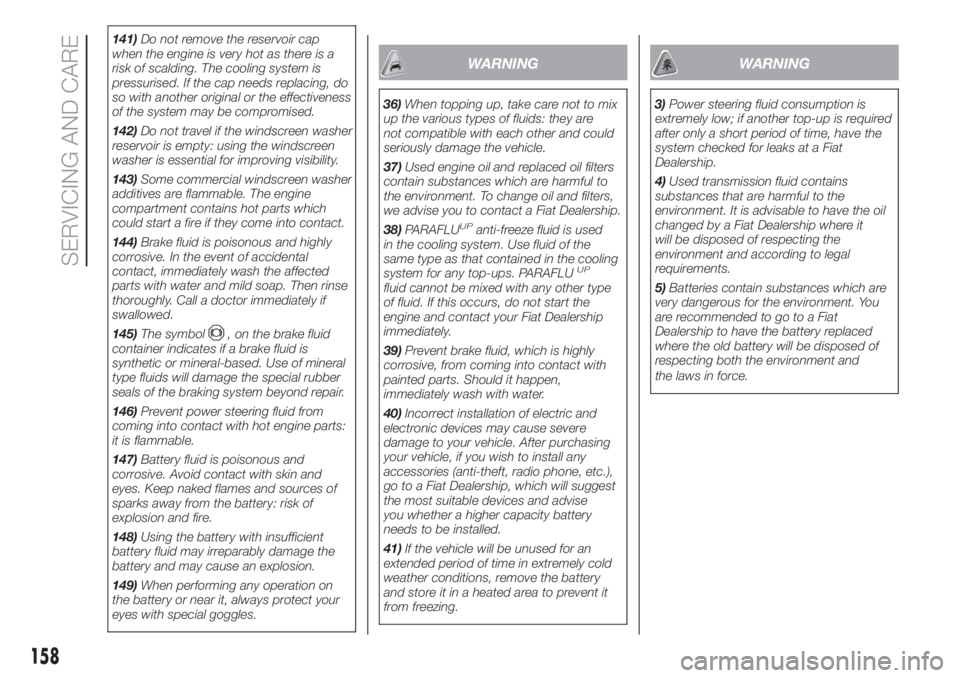
141)Do not remove the reservoir cap
when the engine is very hot as there is a
risk of scalding. The cooling system is
pressurised. If the cap needs replacing, do
so with another original or the effectiveness
of the system may be compromised.
142)Do not travel if the windscreen washer
reservoir is empty: using the windscreen
washer is essential for improving visibility.
143)Some commercial windscreen washer
additives are flammable. The engine
compartment contains hot parts which
could start a fire if they come into contact.
144)Brake fluid is poisonous and highly
corrosive. In the event of accidental
contact, immediately wash the affected
parts with water and mild soap. Then rinse
thoroughly. Call a doctor immediately if
swallowed.
145)The symbol
, on the brake fluid
container indicates if a brake fluid is
synthetic or mineralbased. Use of mineral
type fluids will damage the special rubber
seals of the braking system beyond repair.
146)Prevent power steering fluid from
coming into contact with hot engine parts:
it is flammable.
147)Battery fluid is poisonous and
corrosive. Avoid contact with skin and
eyes. Keep naked flames and sources of
sparks away from the battery: risk of
explosion and fire.
148)Using the battery with insufficient
battery fluid may irreparably damage the
battery and may cause an explosion.
149)When performing any operation on
the battery or near it, always protect your
eyes with special goggles.
WARNING
36)When topping up, take care not to mix
up the various types of fluids: they are
not compatible with each other and could
seriously damage the vehicle.
37)Used engine oil and replaced oil filters
contain substances which are harmful to
the environment. To change oil and filters,
we advise you to contact a Fiat Dealership.
38)PARAFLU
UPanti-freeze fluid is used
in the cooling system. Use fluid of the
same type as that contained in the cooling
system for any top-ups. PARAFLU
UP
fluid cannot be mixed with any other type
of fluid. If this occurs, do not start the
engine and contact your Fiat Dealership
immediately.
39)Prevent brake fluid, which is highly
corrosive, from coming into contact with
painted parts. Should it happen,
immediately wash with water.
40)Incorrect installation of electric and
electronic devices may cause severe
damage to your vehicle. After purchasing
your vehicle, if you wish to install any
accessories (anti-theft, radio phone, etc.),
go to a Fiat Dealership, which will suggest
the most suitable devices and advise
you whether a higher capacity battery
needs to be installed.
41)If the vehicle will be unused for an
extended period of time in extremely cold
weather conditions, remove the battery
and store it in a heated area to prevent it
from freezing.
WARNING
3)Power steering fluid consumption is
extremely low; if another top-up is required
after only a short period of time, have the
system checked for leaks at a Fiat
Dealership.
4)Used transmission fluid contains
substances that are harmful to the
environment. It is advisable to have the oil
changed by a Fiat Dealership where it
will be disposed of respecting the
environment and according to legal
requirements.
5)Batteries contain substances which are
very dangerous for the environment. You
are recommended to go to a Fiat
Dealership to have the battery replaced
where the old battery will be disposed of
respecting both the environment and
the laws in force.
158
SERVICING AND CARE